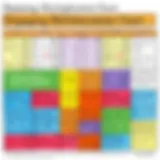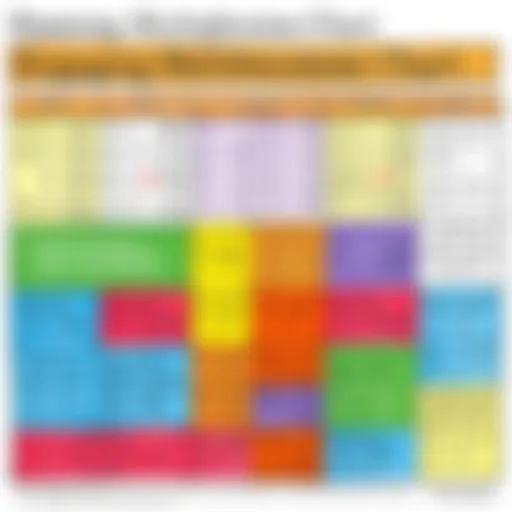Top Free Educational Websites for Pre-K Learning
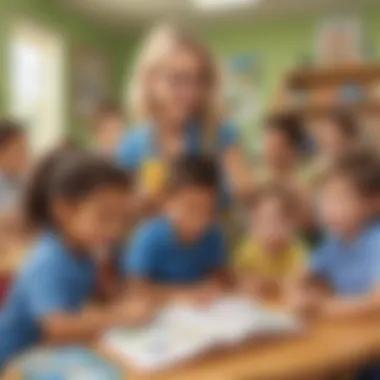

Intro
In a world where technology is advancing at lightning speed, the education sector is not left behind. When it comes to pre-kindergarten education, numerous free online platforms are carving pathways for young minds to learn and grow without the barriers of cost. Engaging these websites can lay a strong foundation in literacy, numeracy, creativity, and critical thinking. Parents and educators now have a treasure trove of resources at their fingertips.
This article focuses on a selection of these websites, offering insights into their features, benefits, and educational aims. By comprehensively exploring these resources, we aim to emphasize their importance in the early stages of child development. Through active engagement, kids can unlock their potential in an enjoyable and interactive environment, which is crucial for fostering a love for learning from an early age.
Creative Activities
As we delve into the myriad of options available, one of the standout features of these educational platforms is the wide variety of creative activities they offer. Tapping into children’s imagination is key, and these sites have made it easy for kids to unleash their creativity.
Craft Ideas
Many free educational websites present simple craft ideas that children can replicate at home or in a classroom setting. Think along the lines of making a spring collage using leaves and flowers or crafting a rainbow using colorful paper. All it takes is some common household items — paper, glue, and a dash of creativity!
Step-by-Step Guides
For each activity, these platforms often provide detailed instructions that both kids and caregivers can follow. These guides include everything from the necessary materials to tips for making the craft even more special. For instance, a guide on creating a handprint dinosaur can outline the exact colors to use and suggest ways to embellish the craft, adding aesthetic value to the child’s artwork.
Educational Value
Engaging in creative activities isn't just about fun; it has significant educational value too. These crafts can enhance fine motor skills, improve focus, and boost cognitive development. As children cut, glue, and assemble, they practice coordination and critical thinking. This hands-on experience solidifies learning in a way that textbooks often cannot achieve.
"Creativity is intelligence having fun." – Albert Einstein
Fun Quizzes
Alongside creative activities, interactive quizzes are crucial in keeping children engaged with the learning material. Many of these websites offer dynamic quizzes designed specifically for young learners.
Quiz Topics
The variety of topics covered in these quizzes is impressive. From shapes and colors to simple math problems and even letters of the alphabet, children are often excited to embark on a quiz journey that feels more like an adventure than a test.
Question Types
Children engage with a mix of question types in these quizzes. They might encounter multiple-choice questions, fill-in-the-blank formats, or interactive puzzles. Such diversity keeps kids interested and encourages them to think critically about their answers.
Knowledge Reinforcement
These quizzes serve an essential function in reinforcing the knowledge gained during imaginative play or reading. When youngsters face questions that challenge what they've learned, they solidify that knowledge in their minds, making it more likely that they will recall it later.
Fact-Based Articles
Finally, a good number of educational websites also publish fact-based articles aimed at young readers.
Topics
These articles can cover a range of engaging subjects. Children might learn about animals, planets, or the seasons, each crafted to whet their curiosity. The content is generally tailored to be both fun and educational, making sure little ones find it interesting while learning something new.
Engaging Content
What sets these articles apart is how they present information in an engaging and accessible way. With colorful illustrations, simple language, and interactive elements, even the youngest readers can absorb knowledge effortlessly. This is particularly effective in nurturing a habit of reading early on.
Prelims to Early Childhood Education
Early childhood education holds the key to laying strong foundations for young minds. At the heart of this educational journey, especially in the Pre-K stage, is the understanding that children are sponges ready to soak up knowledge. This phase is not merely about teaching the ABCs or basic numbers; it centers on nurturing curiosity and fostering social skills. Engaging in structured yet playful educational experiences can instill a lifelong love for learning.
In the growing world of digital education, these early years represent a pivotal moment. Integrating educational websites into early childhood education can greatly enhance this process. It’s important to recognize the role these platforms play in complementing traditional teaching methods. They provide avenues for children to engage in self-directed learning, offering an array of experiences not always available in the classroom. With delightful visuals and interactive elements, children can learn at their own pace, making the process enjoyable and effective.
Understanding Pre-K Education
Pre-K education serves as a bridge between informal learning at home and the formal education system. It’s a unique period where children begin to develop essential skills that will assist them throughout their lives. During this stage, they are not just learning facts but also discovering how to socialize with peers, follow routines, and express themselves. The environment created during these years can cultivate emotional resilience—a critical skill for navigating life’s challenges.
Incorporating technology into this learning landscape is vital. Educational websites designed for Pre-K offer engaging activities that promote literacy, numeracy, and critical thinking. For instance, a simple game where children identify shapes can translate into lessons on problem-solving and decision-making. This interactive approach encourages hands-on participation, making each lesson memorable.
The Importance of Digital Learning Tools
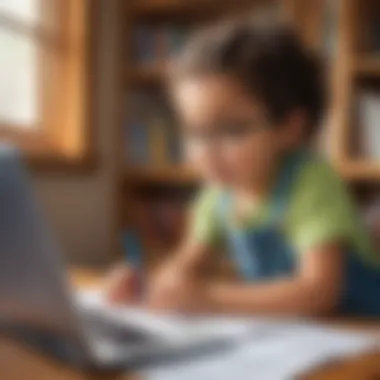

In today’s tech-savvy world, digital learning tools have become an integral part of education. For young learners, these tools can transform the learning experience. They serve as engaging supplements to traditional education methods, catering to various learning styles. Some children may thrive with hands-on activities, while others might prefer visual stimulation; educational websites can cater to both.
Through vibrant animations and interactive quizzes, these platforms make learning accessible and fun. Moreover, they often align their content with early educational standards, ensuring that essential skills are developed. Parents can utilize these resources to track their child's progress, understanding what areas need extra attention.
"Integrating digital tools in early childhood education isn’t just beneficial; it’s essential for a well-rounded learning experience."
The consideration of screen time also comes into play when discussing these digital tools. While moderation is key, the intentional use of educational websites can maximize learning without overwhelming children. By balancing online and offline activities, caregivers can create a rich educational environment.
In summary, the exploration of digital education tools is crucial as we delve into early childhood education, particularly in a Pre-K setting. By understanding what Pre-K entails and the role of digital learning tools, parents and educators can better equip children for a bright future.
Characteristics of Effective Educational Websites
When it comes to introducing young children to the world of learning through online platforms, certain characteristics make one website stand out from another. Effective educational websites for pre-kindergarten children should weave together user-friendly design, interactive experiences, and safety features. These elements collectively ensure that children not only enjoy their learning journey but also reap maximum benefits from digital resources. In this section, we’ll explore each characteristic in detail and highlight why they are crucial in today’s digital age.
User-Friendly Interface
A user-friendly interface is the backbone of an educational website. For pre-K learners, the goal is to keep things as simple and intuitive as possible. A cluttered page can easily overwhelm young minds, making it hard for them to focus on what truly matters: learning.
Children should be able to navigate seamlessly, click on colorful icons, and explore various sections without getting lost. For example, websites like Starfall use bold colors and easily recognizable graphics to help kids jump into phonics exercises or math games.
Here are some essential aspects of a user-friendly interface:
- Simple Navigation: Intuitive layouts that allow kids to find activities easily without needing constant adult guidance.
- Accessible Content: Text should be clear and appropriately sized, ensuring that even children who are still learning to read can understand what to do.
- Responsive Design: Websites that adjust to different devices—whether on a tablet, smartphone, or computer—provide the flexibility needed for family learning environments.
Engagement Through Interactivity
Engagement is a game changer when it comes to educational platforms. Children are naturally curious, and interactivity keeps that curiosity alive. Websites that incorporate games, puzzles, and activities foster a sense of agency. They encourage kids to make choices and see the immediate results of their actions.
Interactive platforms often have features like:
- Fun Quizzes: Short quizzes that break up lessons, giving immediate feedback, and reinforcing what was just learned.
- Hands-On Activities: Websites like PBS Kids feature digital art projects or virtual science experiments that make learning a tactile experience.
- Storytelling Adventures: Through stories that children can influence by making choices, educational websites spark creativity and critical thinking.
Incorporating these engaging elements not only captivates young learners but also embeds important lessons in a memorable way. This way, children don’t just learn; they want to come back for more.
Safety and Privacy Considerations
In this digital age, safety must be a cornerstone of any online educational resource. Parents and caregivers need peace of mind knowing that the platforms their children are using prioritize privacy and security.
Many effective educational websites ensure:
- No Personal Information Required: Kids shouldn’t have to create accounts that ask for too much information. Websites like Cool Math Games allow play without requiring personal details.
- Child-Friendly Content Filters: Sites should implement strong filtering mechanisms to protect kids from inappropriate content. This means an emphasis on educational material that’s thoughtfully curated.
- Clear Privacy Policies: Transparency around how data is used and where it is stored is non-negotiable. Parents should find these easily explained.
While exposure to the online world can be beneficial, it must be done carefully. Strong safety and privacy protocols allow the focus to remain where it should be—on learning.
"The best educational websites blend ease of use, interactive features, and safety, creating an enriching learning landscape for young explorers."
These characteristics lay the essential groundwork when evaluating educational websites for pre-kindergarten children. An effective platform does more than just present information; it fosters growth, creativity, and a lifelong love of learning.
Comprehensive List of Free Educational Websites
When it comes to enriching the early learning experience, a well-rounded assortment of free educational websites is a goldmine for both educators and parents. Such platforms not only keep the little ones engaged but also serve as mediums through which foundational skills can be instilled effortlessly. Here, the focus is on several key aspects, namely the wide range of skills covered, the access to high-quality content, and the variety of interactive features that cater to different learning styles. These resources are pivotal in ensuring that early education is not just another mundane task but a delightful journey of discovery and growth.
Website Overview
A proper introduction to the world of educational websites for Pre-K children opens up numerous possibilities. Generally, these sites serve as virtual classrooms filled with engaging content that addresses crucial developmental milestones. Crafting a balance between play and learning, these websites offer activities tailored to diverse age groups and skill levels, making them inviting for little explorers.
Websites Focused on Literacy Skills
Starfall
Starfall is simply great for young readers. It specializes in phonics and basic literacy. What makes Starfall especially valuable is its engaging format that seamlessly blends animation with learning. This website is a strong contender in the realm of early reading. Its interactive storybooks not only hold a child’s attention but also reinforce skills through practice. The focus on phonemic awareness sets Starfall apart, encouraging kids to sound out words and develop reading confidence. However, the free version does have limited content, which may leave some users craving more.
Storyline Online
Storyline Online elevates children's storytime with a twist. This unique platform features renowned actors reading popular children's books aloud. The captivating stories enhance literacy skills, making it a beneficial choice for both entertainment and education. What sets it apart is the auditory experience that brings literature to life. Its videos also come equipped with supplementary activities, but since it's more passive in nature, it may lack the interactivity that some children thrive on.
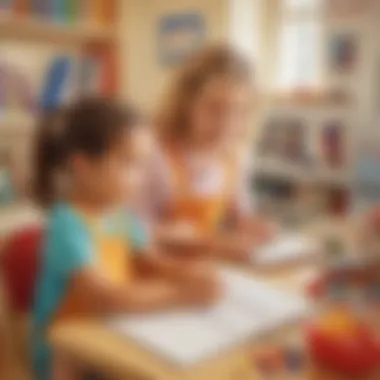

Read.gov
Read.gov embodies a government-supported initiative aiming to promote reading among young minds. The site offers a rich collection of classic children's literature available online. This resource not only fosters literacy but also instills a sense of cultural appreciation through its timeless tales. The key characteristic lies in the accessibility of quality literature. Although the website promotes reading, parents should take note of the need for additional interactive elements to keep engagement levels up.
Websites for Math Literacy
ABCya
ABCya stands out in the realm of math education. It offers a plethora of games designed to teach basic math concepts, such as addition, subtraction, and shapes. The vibrant design and myriad of options make it appealing and fun for pre-K kids. The key attraction is the game-based learning approach that supplies instant gratification through successful problem-solving. However, some parents have noted that depending solely on games may not build a solid understanding of math principles, so moderation is essential.
Funbrain
Funbrain is not just any educational platform; it strikes a perfect balance between fun and learning. It features games that incorporate math problems into engaging narratives, which keeps kids coming back for more. The interlinking of stories with math activities ensures that children practice essential skills while kinda forgetting they are working. The downside may be that some activities are less aligned with standard curriculums, which could hinder consistency in learning objectives.
Cool Math Games
Cool Math Games goes beyond conventional learning mechanisms. It brings together logic-based games designed to sharpen problem-solving skills. The unique angle here is the focus on strategy and critical thinking rather than rote memorization. With a vast selection of games, kids can find joy while learning math concepts. However, parents should monitor gameplay time, as it's easy for kids to get consumed by the gaming aspect, potentially sidelining the educational goal.
Science and Nature Exploration Platforms
National Geographic Kids
National Geographic Kids takes young learners on a thrilling journey through nature and science. This platform excels by offering a treasure trove of articles, interactive games, and videos about wildlife and the environment. The engaging visual content sparks curiosity, encouraging kids to ask questions and ignite their imaginations. While it's a rich resource, some content may be too complex for very young children, necessitating guidance from adults.
PBS Kids
PBS Kids provides a well-structured approach to learning across various subjects, including science. The website features beloved characters from PBS programming guiding children through educational adventures. The engaging mix of videos, games, and printable activities makes it a favorite among families. However, constant internet access is necessary to enjoy its array of materials, which might pose challenges for some.
NASA's Space Place
NASA's Space Place is simply out of this world! It invites children to explore the universe in a kid-friendly manner. The site offers hands-on activities, articles, and games all centered around space science. It's a unique resource that encourages scientific exploration in a fun way. Despite its immense value, the advanced concepts may be challenging for some pre-K kids without adult assistance.
Art and Creativity Websites
Crayola Creativity Corner
Crayola Creativity Corner is a haven for budding artists. This website motivates kids to express their creativity through a variety of coloring activities and art projects. The interactive tools like virtual coloring pages and craft ideas keep the enthusiasm high. However, while it encourages creativity, the site may not emphasize skills like drawing fundamentals as much as some might hope.
Art for Kids Hub
Art for Kids Hub offers a plethora of options for creative expression. It has numerous instructional videos that guide children through a range of art techniques using simple materials. The focus on hands-on art projects is hugely beneficial. However, the dependency on watching videos might limit spontaneous creativity, requiring adults to prompt kids for a balance.
Drawize
Drawize brings the traditional drawing experience into the digital age, allowing kids to participate in online drawing games. The interactive aspect makes drawing a collaborative experience, fostering social skills as children create together. What’s appealing here is the blend of technology and creativity. Nonetheless, children may require some supervision to navigate the platform safely.
Games and Fun Learning Activities
Kahoot!
Kahoot! revolutionizes quizzes, making them interactive and incredibly fun. This platform can transform learning into an exciting game show. Teachers and parents can create custom quizzes tailored to the material they want children to review. However, it mainly caters to group settings, which may not be as effective for one-on-one learning situations.
Sesame Street Games
Sesame Street Games employs beloved characters to create educational magic. The platform specializes in preschool skills, from literacy to social-emotional learning. The representation of familiar characters offers a comforting experience for kids. The downside might be that while highly engaging, the content scope may not be as extensive as those offered by some other platforms.
Nick Jr. Games
Nick Jr. Games merges entertainment with education seamlessly. Focused on early childhood learning, the games cover a variety of subjects. The interactive nature encourages kids to learn through exploratory play. However, it’s worth mentioning that some parents express a need for diverse learning outcomes beyond what the platform offers.
By thoughtfully exploring these educational websites, caregivers can equip pre-K learners with tools to develop essential skills. Each of these platforms brings something unique to the table, enriching children's learning experiences while keeping them engaged.
Assessing the Educational Value
When it comes to the realm of pre-kindergarten education, not every website that's out there is suitable for our little learners. That’s where the concept of assessing educational value steps in, like a trusty compass guiding educators and parents through the vast sea of online resources. It’s crucial to consider how effectively these websites can support early childhood development. This section seeks to unravel the various elements that contribute to educational value, looking at how websites can align with curriculum standards, encourage critical thinking, and provide useful feedback.


Alignment with Educational Standards
The best free educational websites for preschoolers don't just entertain; they also adhere to educational standards that ensure a solid foundation for kids. We’re not looking for a haphazard mix of activities, but rather structured content that matches state or national learning guidelines. Websites that align with these standards often feature clear objectives for learning, which parents and teachers can use to benchmark progress.
For example, consider a site like Starfall, where the activities promote literacy skills in a way that corresponds with what educators expect children to grasp at a young age. This alignment is significant because it helps ensure that children are not only engaged but also gaining skills necessary for their academic journey. Websites that follow educational guidelines often provide additional resources or guidelines for parents, which empowers families to support their child's learning effectively at home.
Activities That Foster Critical Thinking
Here’s the thing: fostering critical thinking is not just reserved for older students. Even the youngest learners can benefit from opportunities that challenge their brains. Activities designed to promote critical thinking encourage children to ask questions, solve problems, and think creatively.
Websites like PBS Kids shine in this area, offering interactive games and storylines that require kids to make decisions and navigate challenges. Activities may range from simple puzzles to more complex scenarios that encourage young minds to consider different outcomes. Even color choices in art activities are opportunities to think critically about combinations and their effects. This early exposure to critical thinking principles sets a robust groundwork for their future learning experiences.
Feedback and Progress Tracking Features
Imagine a scenario where children engage in learning, and their progress is tracked seamlessly. This is where feedback and progress tracking comes into play. Sites that provide real-time feedback help children understand their strengths and pinpoint areas needing improvement.
For instance, websites like ABCya offer games that adapt to each child's performance. If a child struggles with a specific math concept, the program adjusts to include additional practice in a kid-friendly format. This kind of responsive design not only boosts confidence through positive reinforcement but also guides children along their learning path. Knowing how close or far they are from their goals provides both motivation and clarity about their unique learning journey.
Challenges and Considerations
In our examination of free educational websites designed for pre-kindergarten children, it is essential to address the challenges and considerations that may arise when integrating these digital tools into learning routines. Understanding the kinds of barriers that can take shape and the broader implications surrounding their use is vital for maximizing their educational value. While the benefits of online learning platforms are numerous, parents and educators must navigate a landscape filled with nuances related to access, screen time, and the balance of learning environments. This section explores these challenges in detail.
Digital Divide and Access Issues
The digital divide refers to the gap between those who have easy access to the internet and digital devices and those who do not. This divide can manifest in various ways, affecting the educational opportunities available to children. Many families may lack the necessary devices or stable internet, putting their kids at a disadvantage.
Access issues can also lead to unequal learning experiences, particularly exacerbated during challenging times, such as the pandemic, when education shifted online
- Considerations to Keep in Mind:
- Check if the websites are accessible on multiple devices, including tablets and smartphones.
- Seek out community resources like public libraries or community centers for internet access.
- Recognize that some families may require support, like guidance on using these resources effectively.
"Equitable access to educational resources is crucial; without it, we risk leaving our most vulnerable learners behind."
Screen Time and Its Implications
Navigating the amount of screen time children are exposed to is a topic that raises eyebrows and concerns among many parents and educators. While digital learning can be immensely beneficial, excessive screen time can lead to issues like decreased attention spans, disrupted sleep, and a lack of physical activity. It’s not all doom and gloom, though.
To ensure that screen time is constructive, it can be beneficial to:
- Establish clear guidelines on how long children can use educational websites each day.
- Encourage breaks and incorporate physical activities to balance time spent online.
- Facilitate discussions about what they learn online to clarify understanding and promote retention.
Balancing Online and Offline Learning
A strong educational experience for pre-K children shouldn’t hinge solely on online resources; rather, it should strike a balance between online and offline activities. While interactive educational websites offer numerous benefits, traditional methods of learning continue to play a critical role in child development.
To achieve this balance, consider the following:
- Integrate hands-on activities that relate to what they learn online. For example, if a child learns about vegetables through a digital game, have them help with a cooking session using real ingredients.
- Encourage social interactions. Kids benefit from group play and cooperative learning experiences, which can’t be replaced by screens.
- Promote reading physical books, allowing children to engage their imaginations without digital distractions.
Ultimately, while free educational websites are powerful tools, integrating them with other aspects of learning creates a more comprehensive education. Recognizing the challenges and considerations can help parents and educators make informed choices, tailoring learning experiences that are as rewarding and enriching as possible.
The End: Enhancing Pre-K Education
In the context of early childhood education, the integration of free educational websites presents a valuable opportunity for both children and their caregivers. These resources are not mere tools; they serve as bridges connecting young learners to a world filled with knowledge and creativity. As we conclude our exploration, it's crucial to underscore the specific elements contributing to the enhancement of Pre-K education through these platforms.
The Role of Parents and Educators
The involvement of parents and educators is instrumental in maximizing the benefits derived from educational websites. Parents can guide children's online experiences, ensuring they engage with content that aligns with their learning needs. Setting aside dedicated time for educational activities reinforces concepts learned and encourages shared exploration. For instance, after a session on numbers using ABCya, parents might follow up with hands-on counting exercises involving common household items, turning digital learning into a tangible experience.
Moreover, educators play a pivotal role by selecting appropriate websites that complement their curriculum. They can introduce these platforms into lesson plans, emphasizing skills such as problem-solving and creative thinking. Feedback from teachers about what resonates most with children can help continually refine the use of these resources. In this way, parents and educators form a partnership that not only enhances learning but cultivates a love for education early on.
Looking Ahead: Future Trends in Educational Technology
The landscape of educational technology is continually evolving, presenting new possibilities for enhancing Pre-K education. One notable trend is the increasing incorporation of artificial intelligence into learning platforms. This technology can tailor learning experiences to suit each child's pace and style. Imagine a website that adapts its games and stories based on how well a child performs; it would likely keep children more engaged than static content.
Another trend emerging is the integration of augmented reality (AR) in educational apps. For example, a science website could allow kids to explore the solar system through interactive, 3D models on their screens. These immersive experiences could captivate young minds and deepen their understanding of complex concepts in a fun way.
As we anticipate these advancements, it's equally important to keep discussions about digital wellbeing at the forefront. Balancing screen time with offline activities will remain essential. The aim should be to create a harmonious blend of online learning with traditional play and exploration.
"Education is not preparation for life; education is life itself." - John Dewey
In summary, as we reflect on the role of free educational websites in enhancing Pre-K education, it becomes evident that they are not standalone resources. Instead, they are part of a larger educational ecosystem where parents, educators, and technology converge to provide a rich learning experience for children. By leveraging these tools wisely and keeping an eye on future trends, we can foster an enriching environment that meets the diverse needs of young learners.


